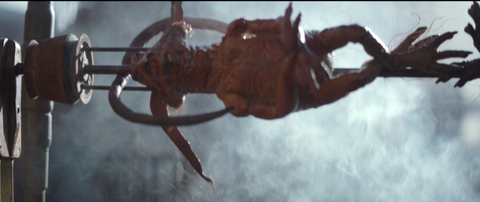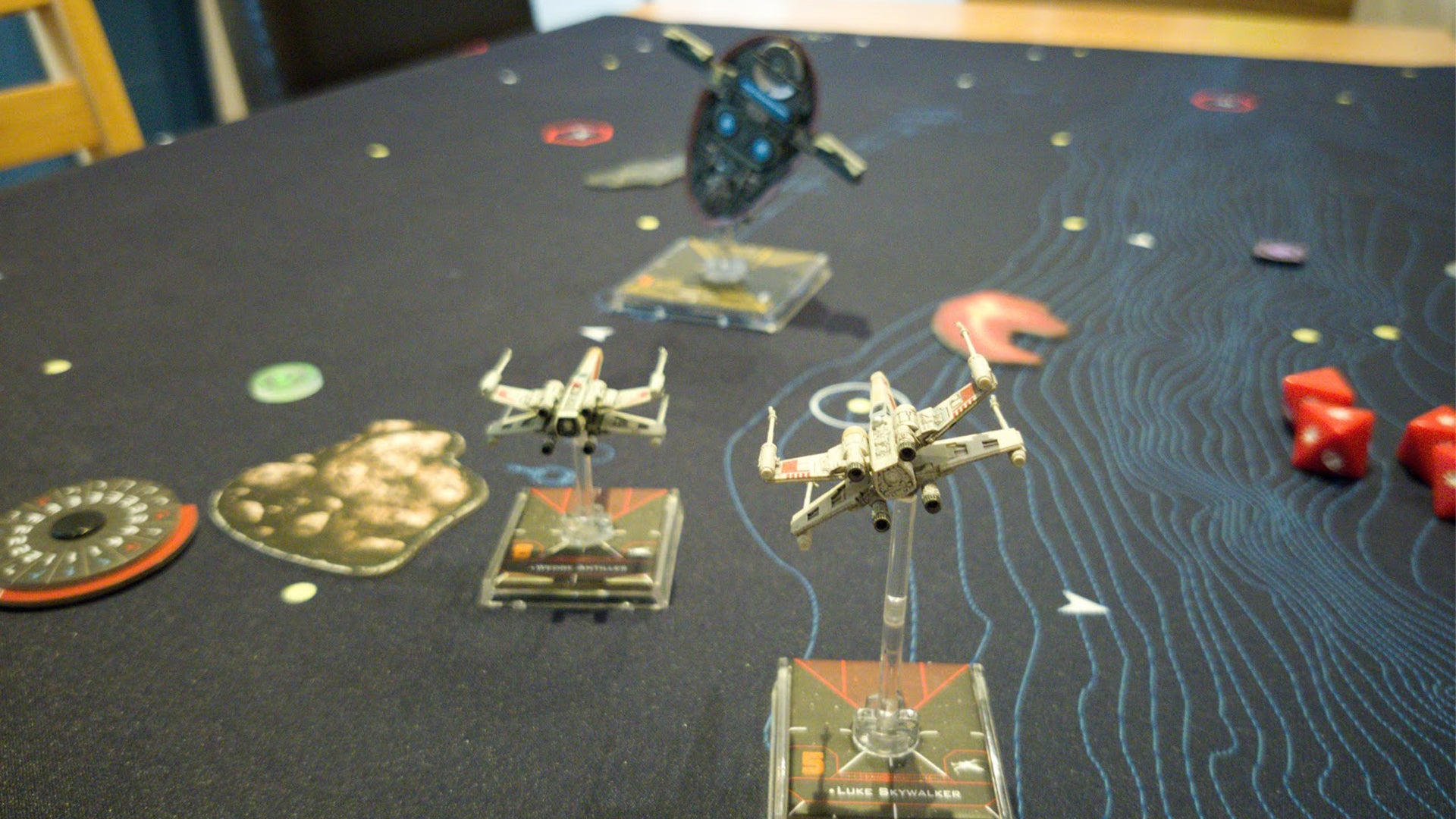Two and a half years ago I wrote a series of posts about adapting Cortex Prime for Star Wars. I’ve had some sessions and learned some lessons since then, not just about StarCortexPrimeWars but also about what parts of the expansive Cortex toolkit work best for me. As usual, preferences vary, I’m not your dad, do what you like. Let’s go.
What Flavor of Star Wars?
Star Wars contains multitudes and is many things to many people. I’ve had the most fun with Rebel spies, saboteurs, and soldiers in the vein of Rogue One, the Mandalorian, and the old Dark Forces games, maybe with a bit of Solo in there. The Force is present but not overwhelming.
Most recently, my jam has been Inglourious Banthas – Rebel badasses hunt down Imperial officers and Moffs lying low after the Empire’s defeat at Endor and deliver consequences.
What Flavor of Cortex Prime?
I’ve spent far too much time overthinking ways to complicate Cortex to model some facet of the Star Wars setting but all you really need are the right prime trait sets.
One Shot or Campaign?
Do you only have one session to get everything done or do you need characters with room to grow and change? If you’re not providing full pregens for a one-shot, think hard about the number of choices your players have to make and how many freeform responses they’ll need to invent from whole cloth (like writing distinctions).
Distinctions
Every Cortex Prime character has distinctions, but here’s the thing. Distinctions are there to provide a free d8 in your pool and give the option of earning Plot Points when you swap out the d8 for a d4. Don’t agonize over which distinction fits which action best, because guess what? It’s a d8 no matter what.
Distinctions should tell us who your character is and why they’re in this session. For Inglourious Banthas, it’s important to know what the Empire took from each character. That should be a distinction.
For One Shots: Try to only have a single freeform distinction that players need to fill in. Come up with picklists or choose appropriate distinctions ahead of time, following Cortex Prime’s advice on archetypes.
For Campaigns: You can tie different SFX to different distinctions. A distinction about a character’s reputation could have a trait statement that can be challenged during play. You could also rank distinctions by die type, but in my experience it’s smoother in play if you have to talk through fewer trait sets for each roll.
Roles
My favorite prime set for Star Wars has been Roles, and after much deliberation I’ve settled on the following, adapted from this excellent tweet.
Rate them with a d10, d8, d6, d6, d6, and a d4. For longer play, you could use a skill list or specialties. As it is, there’s going to be some wiggle room. Talk through your pool as you build it, because that’s one of the fun parts of Cortex.
Ace
- Daring pilot stunts
- Spacecraft maintenance
- Rebel esprit de corps
- Big heroic speeches
Cowpoke
- Rooting, tooting, shooting
- Animals (riding, hunting)
- Scruffy charm
- Friends in low places
Robot
- Cool armor
- Weird weapons
- Knowing facts
- Slicing
Spy
- Lies and alibis
- The political situation
- Sneaky deaky
- Oh my god it’s a mirage I’m telling all y’all it’s a sabotage
Warrior
- Physical prowess
- Courage in the face of death
- Good at swords
- “No, you move”
Wizard
- Hunches and vibes
- Poorly defined magical powers
- Ancient history
- Acting all cool and mysterious

Affiliations – the Flavorful Option
Average them all out to a d8; if you step up one affiliation, step down another. Generally if the action itself isn’t aligned with a particular affiliation, chances are the target of that action is. Fixing a starship is a pretty generic task, so look at the type of ship – Imperial shuttle or Rebel fighter. Sometimes the action itself suggests an affiliation – shooting stormtroopers is pretty much always Rebel, but tricking stormtroopers is probably Imperial. Using a lightsaber or digging around in ruins is going to be affiliated with Jedi. Finally, if literally nothing else works just use Scum.
Rebel
Republic gear, codes, safehouses, ships, contacts, screaming no at something bigger than you
Imperial
Imperial gear, ships, codes, tactics, persons of interest, blending in with your oppressors
Scum
Tramp freighters, crimelords, bounty hunting, smuggling, criminal networks
Jedi
Jedi, Sith, hokey religions and ancient weapons, mysterious temples, Force lore
For One Shots: The problem with affiliations for one shots is that there’s very little chance you’re going to be able to squeeze in all four choices evenly. A Force-light scenario might not see anyone roll their Jedi affiliation, for example. Affiliations tend to get balanced out over a longer campaign. I recommend Attributes, up next.
For Fighter Pilots: I heartily recommend Ace/Wingman/Squadron/Crew if you’ve got a game where everyone’s a pilot.
Attributes – The Simple Option
There is definitely something to be said for speed and simplicity. Cortex Prime’s suggested trio of Physical/Mental/Social works perfectly fine, especially in concert with the Roles prime set above. Want to get up on that landspeeder and inspire your partisan allies before the battle? Ace+Social. Need to drive that same landspeeder in the battle? Ace+Physical, and so on.
Like Affiliations, average your attributes to a d8. Stepping up one means you step down another.

Other Trait Sets
The prime sets I’ve listed here assume you’ve got a fairly broad range of character concepts and abilities, just like most of the Star Wars films and shows.
Relationships
Relationships make a superb bonus trait set when you’ve got a squad or crew. Look at Hammerheads in the Cortex Prime book for examples – I recommend a picklist because your players will have already spent creative energy writing distinctions. “X is going to get us all killed” is a great option.
For Campaigns: Treat relationships as trait statements you can challenge and rewrite. You get bonus dice for those pivotal moments and your characters get to change and grow.
Skills
Skills are a no-nonsense alternative to Roles. They both show what your character is good at, except there’s more skills so they fit long-term advancement better over a campaign. If you’re going with skills for a one shot, try to prepare some “skill packages” ahead of time so you don’t lose time or burn out players by making too many little decisions.
Values
Values are a good option when your group is cohesive, like an all Jedi party or a fighter squadron. When you talk through your actions, values let you differentiate your character even though you might all be flying an X-Wing or throwing stormtroopers off guardrail-less walkways with your mind.
Mods
Cortex Prime is always a little DIY. First off, I’ve gotten by with simple tests and contests. They get it done fast so you can keep things moving. I just haven’t needed to use action order yet.
Force Points
Oh look, I renamed Plot Points (PP) to Force Points (FP). You start with 1. Otherwise they work exactly the same. Game design!
Static Difficulty
Using static TNs for tests helps speed things up and lessens how swingy Cortex Prime can feel sometimes. If you’re using a Doom Pool, you can ignore this of course. I don’t have any experience with using the Doom Pool. I plan to try it out next chance I get. It might be a gamechanger.
Scale
If it’s bigger than you but not so big the outcome is a foregone conclusion, the bigger thing gets a d8 scale die and adds a third die to its total for free.
Starships
Ships have 3 attributes. When taking vehicular actions, add the most relevant ship attribute to your pool.
Stress
While characters will follow regular complication rules, vehicles will use stress to their attributes as well as the shaken/stricken rules. One Shots: Don’t use stress for one shots, nobody has time for that.
Engines
Ships with high engines are faster and more agile. Straight-line speed or extreme maneuverability is best called out with distinctions.
Systems
Sensors, targeting systems, astrogation, communications. Higher Systems dice indicate a technological advantage. If that advantage comes from state-of-the-art prototypes or jury-rigged ingenuity, yup, use a distinction.
Hull
A high hull die doesn’t necessarily mean your ship is large (use scale for that), but it’s definitely tougher.

SFX
Here’s a big list of Star Wars-flavored abilities you can attach to distinctions or use as talents. Enjoy!
- 360 No Scope: Step up a weaponry asset when you’re in an exposed position and your weapon is ill-suited to the situation.
- Beep Boop: Step up assets created from slicing.
- Cape Room: Step up any wardrobe- or disguise-related assets.
- Felucia Death Crawl: Step up or double your Cowpoke die when contending with wilderness misadventures.
- First One’s Free: Spend a FP, kill a minion.
- Frimmin’ on the Frim Fram: Step up your effect die when contending with droids outside of direct combat.
- Full of Surprises: Step up a signature asset. It’s also broadly applicable, like “Multi-tool Arms” or “Walking Arsenal”.
- Get Out And Push: Step up assets you create to assist other characters, or step up any helping dice you pass to another character.
- I Don’t Need Luck, I Have You: When a teammate fails a roll in a test or contest, you can give them your relationship die at no cost for their next roll.
- I Have a Bad Feeling About This: Say the thing, earn a FP, then create a d8 “Bad Feeling” complication.
- I Have You Now: Earn a FP when you say a one-liner, create a d8 “Overconfident” complication, then roll.
- I Live My Life Twelve Parsecs at a Time: Step up or double your Ace die when you use a vehicle to outrun someone.
- I Was About to Clear Them: Spend a FP to create or step up a d8 “Clearances” (or similar) asset for the scene.
- Let the Wookiee Win: Spend a FP to succeed at a feat of great strength. You may roll to do strong things when others cannot.
- She’ll Hold Together: When you spend a FP to push vehicle stress, do not step up the die after the test or contest is resolved.
- Shoot First: Step up or double Cowpoke if you start the fight.
- Six Million Forms of Communication: You can talk to it even if nobody else can. You also step up your effect die in matters of etiquette and protocol.
- Size Matters Not: Spend a FP to step up or double your Wizard die for the scene.
- Strong in the Force: You may include your Force relationship die in your pool at no cost.
- The Face of a Friend: Step up your Spy die for the scene until you reveal your true intentions or resort to violence.
- They Told Me They Fixed It: Create or step up a “Jury-rigged” complication when repairing or building something, then step up or double your Ace die for the scene.
- This is the Way: Earn a FP when your moral code makes things more difficult.



One thought on “Star Wars With Cortex Prime, Episode I”